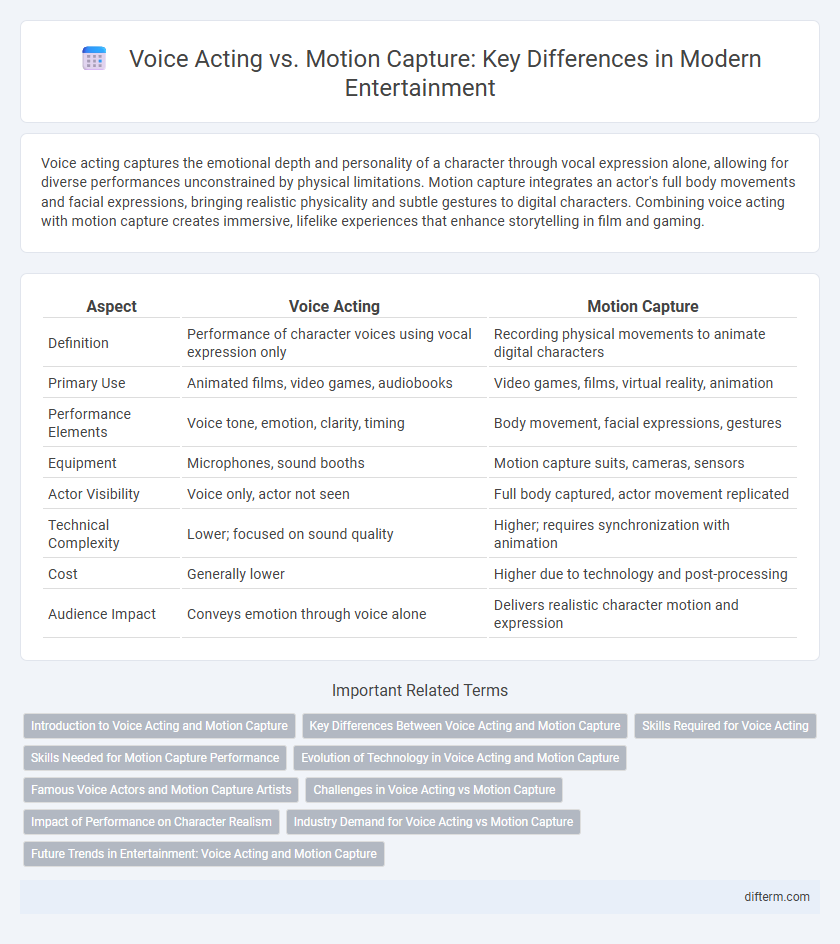Voice acting captures the emotional depth and personality of a character through vocal expression alone, allowing for diverse performances unconstrained by physical limitations. Motion capture integrates an actor's full body movements and facial expressions, bringing realistic physicality and subtle gestures to digital characters. Combining voice acting with motion capture creates immersive, lifelike experiences that enhance storytelling in film and gaming.
Table of Comparison
| Aspect | Voice Acting | Motion Capture |
|---|---|---|
| Definition | Performance of character voices using vocal expression only | Recording physical movements to animate digital characters |
| Primary Use | Animated films, video games, audiobooks | Video games, films, virtual reality, animation |
| Performance Elements | Voice tone, emotion, clarity, timing | Body movement, facial expressions, gestures |
| Equipment | Microphones, sound booths | Motion capture suits, cameras, sensors |
| Actor Visibility | Voice only, actor not seen | Full body captured, actor movement replicated |
| Technical Complexity | Lower; focused on sound quality | Higher; requires synchronization with animation |
| Cost | Generally lower | Higher due to technology and post-processing |
| Audience Impact | Conveys emotion through voice alone | Delivers realistic character motion and expression |
Introduction to Voice Acting and Motion Capture
Voice acting involves performers providing character voices using their vocal skills to bring animated characters and video games to life, emphasizing tone, emotion, and timing. Motion capture captures actors' physical movements through sensors and cameras, translating real-life performances into digital character animations for films, games, and virtual reality. Both techniques are fundamental in modern entertainment, enhancing storytelling by combining vocal expression with realistic physicality.
Key Differences Between Voice Acting and Motion Capture
Voice acting primarily involves delivering vocal performances to convey character emotions, relying solely on voice modulation, tone, and timing, while motion capture captures full-body movements and facial expressions to create realistic animations. Motion capture actors wear specialized suits with sensors that translate physical actions into digital data, enabling characters to move authentically in video games and films. Voice acting demands strong vocal control and versatility, whereas motion capture requires physical agility and precise mimicry of movements.
Skills Required for Voice Acting
Voice acting demands precise vocal control, emotional versatility, and the ability to convey character through sound alone, without physical cues. Mastery of diction, timing, and breath control are essential skills to create engaging and believable performances. Unlike motion capture, voice actors rely solely on their voices to bring animated characters to life, requiring a deep understanding of tone, pitch, and rhythm to evoke emotion effectively.
Skills Needed for Motion Capture Performance
Motion capture performance demands a unique blend of physical dexterity, spatial awareness, and nuanced emotional expression to convincingly bring digital characters to life. Actors must possess advanced body control, stamina, and the ability to interpret complex choreography while maintaining consistent character continuity in a studio environment. Mastery in integrating vocal performance with precise physical movements distinguishes successful motion capture artists from traditional voice actors.
Evolution of Technology in Voice Acting and Motion Capture
Advancements in voice acting technology have introduced high-fidelity microphones and AI-driven voice modulation, enabling more expressive and nuanced performances tailored for diverse media platforms. Motion capture has evolved with enhanced sensor accuracy and real-time rendering, allowing actors' precise physical movements and facial expressions to be seamlessly integrated into digital characters. These technological breakthroughs have collectively transformed entertainment production, creating more immersive and emotionally engaging experiences for audiences.
Famous Voice Actors and Motion Capture Artists
Famous voice actors like Troy Baker and Jennifer Hale have become icons through their distinct vocal performances in video games and animation, delivering nuanced character emotions solely through voice. Motion capture artists such as Andy Serkis revolutionize entertainment by combining physical acting with digital technology to bring characters like Gollum in "The Lord of the Rings" to life. The integration of voice acting and motion capture increasingly defines modern storytelling, enhancing realism and audience immersion in movies and interactive media.
Challenges in Voice Acting vs Motion Capture
Voice acting faces challenges such as conveying emotion and character solely through vocal performance without physical cues, requiring skilled vocal control and versatility. Motion capture demands precise physical movements and facial expressions to authentically represent characters, often necessitating extensive training and stamina for long recording sessions. Both disciplines require synchronization with digital environments, but voice actors rely heavily on imagination while motion capture artists must physically embody their roles.
Impact of Performance on Character Realism
Voice acting captures the emotional depth and nuances of a character's personality through vocal expression, greatly enhancing narrative engagement. Motion capture translates an actor's physical movements and facial expressions into digital form, providing realistic body language and subtle gestures that elevate character authenticity. Combining both techniques results in immersive, lifelike characters that resonate more deeply with audiences, advancing the standards of realism in interactive entertainment.
Industry Demand for Voice Acting vs Motion Capture
Industry demand for voice acting remains strong, driven by the expanding video game, animation, and audiobook markets that require versatile vocal talent to bring characters to life. Motion capture is increasingly sought after in high-budget films and AAA games, where realistic physical performances enhance immersive storytelling and visual effects. Despite this growth, voice acting maintains broader opportunities due to its adaptability across different media formats and lower production costs.
Future Trends in Entertainment: Voice Acting and Motion Capture
Emerging technologies such as AI-driven voice synthesis and advanced motion capture systems are reshaping entertainment production by enabling more immersive and realistic character performances. Motion capture is evolving with real-time rendering and full-body tracking, facilitating seamless integration into virtual environments and enhancing interactive storytelling. Voice acting benefits from neural voice cloning and emotional recognition, allowing actors to deliver nuanced performances remotely and expanding creative possibilities for character development.
Voice acting vs Motion capture Infographic

 difterm.com
difterm.com